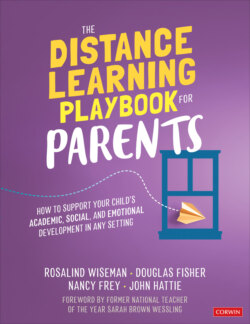Читать книгу The Distance Learning Playbook for Parents - Rosalind Wiseman - Страница 13
На сайте Литреса книга снята с продажи.
Establish Routines
ОглавлениеWhen your child attended physical school, there were any number of routines that she engaged in on a daily and weekly basis. There was a time to get up. There was tooth brushing, hair combing, and eating breakfast—all to be done by a certain time every day. There was getting ready for school. There was coming home from school. Each family has a way of accomplishing these things. In many families, that all fell apart in the pandemic. Students were showing up to virtual school not having eaten, not looking groomed, and even sleepy.
One of the best practices we can enact during distance learning is to establish routines for children. It’s comforting and predictable. And predicable routines are known to reduce stress. Over time, these become habits that don’t take any cognitive energy.
We cannot tell you the best time in your family to ensure that children wake up, bathe, brush their teeth, eat, and complete the range of personal care tasks required for hygiene and health. What we can tell you is that if you create a schedule and follow it, your quality of life will increase, and the stress level of your children will decrease.
YOU KNOW YOUR CHILD BEST. IT’S NOT WORTH A DRAMATIC BATTLE TO IMPLEMENT ALL THESE RECOMMENDATIONS.
It’s important that children feel like they are going to school, even when they are learning from a distance. It’s a mindset that we’re looking for. And when they are ready for school, and look like they are ready for school, they’re a little less worried about appearing online. If your routines have fallen apart a bit, we recommend developing a written schedule for the major tasks that need to be completed, appropriate for the age of the child, of course. Even consider making lunch the night before if that was your habit previously. It sends the message that tomorrow is a school day. And, figure out which alarm clock system will work for your family and an agreed accountability strategy if someone oversleeps.
For example, in the Johnson family, they created a bathroom checklist for their three children, ages 5, 7, and 10. As Matt said, “I know it sounds silly and that we should have thought about it on our own, but when we created the checklist it took away some of the conflict in our family. We used to fight about these things. Now, we check the list and only focus on things that didn’t get done.” After four weeks of the checklist, habits had been formed and they didn’t need to use it any longer.
As part of the routines, remember that chores are also important as they instill responsibility in young people. They teach responsibility, self-reliance, teamwork, time management, respect, and help build a work ethic. When we were young, none of us remember really liking our chores, but we do remember the sense of accomplishment we experienced when they were completed. Children need to learn that their investment in the household benefits everyone.
Consider the routines that are important for your family to function and the habits you want to build in your children. These are the key messages:
➔ Identify the self-care needs of your children and develop routines for them to accomplish the tasks.
➔ Develop a schedule, if needed, for your children to follow the routines.
➔ Make sure that your children are ready for school each day.
➔ Develop a list of chores that children need to complete.
➔ Avoid negotiating schoolwork versus chores.
